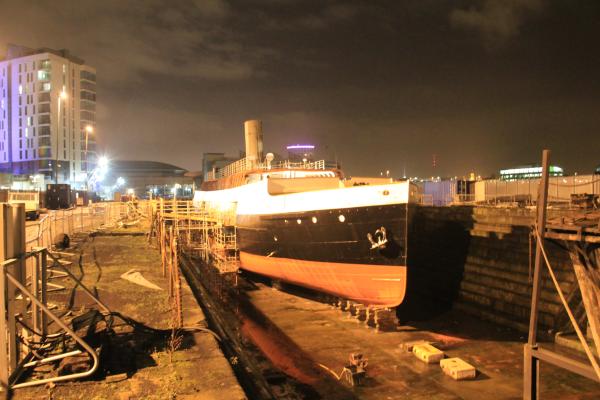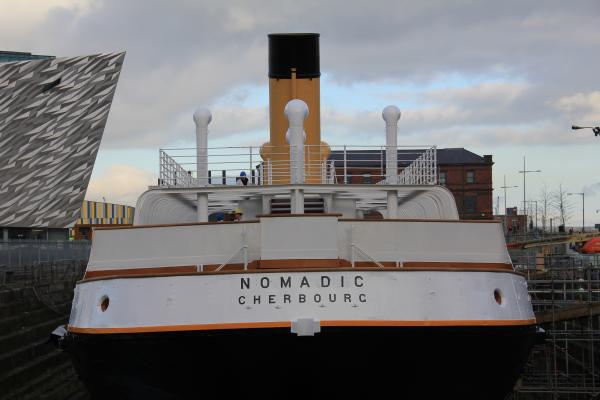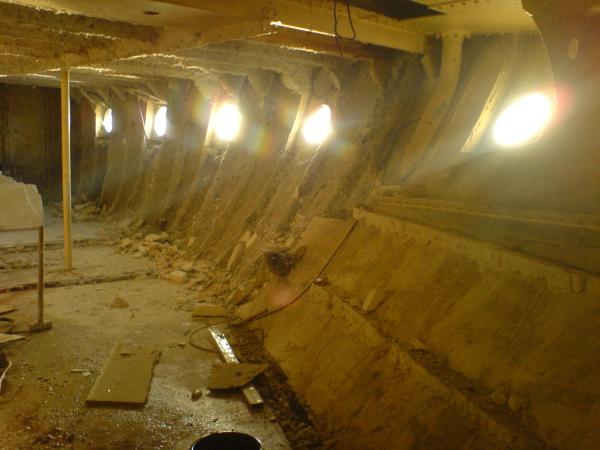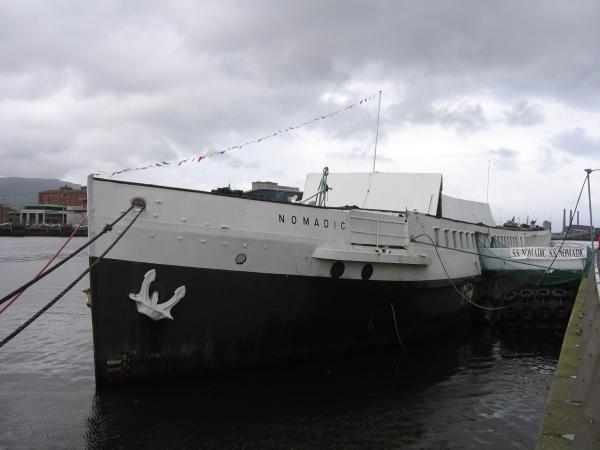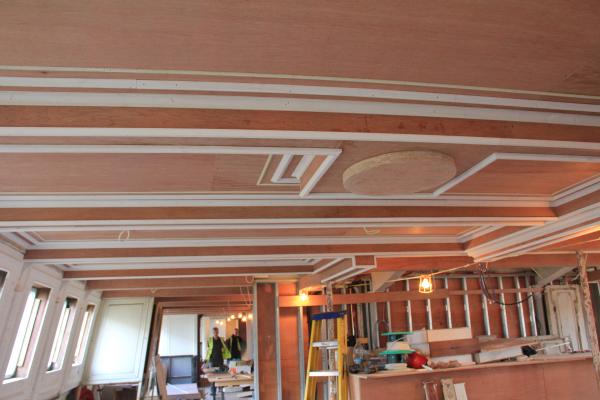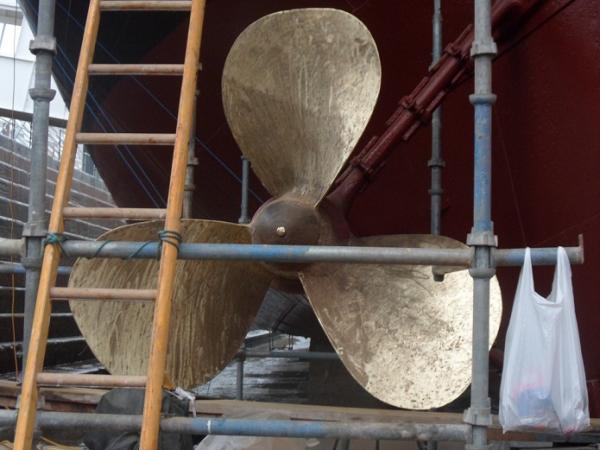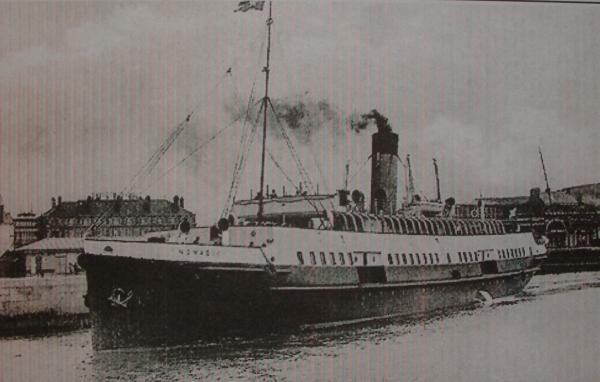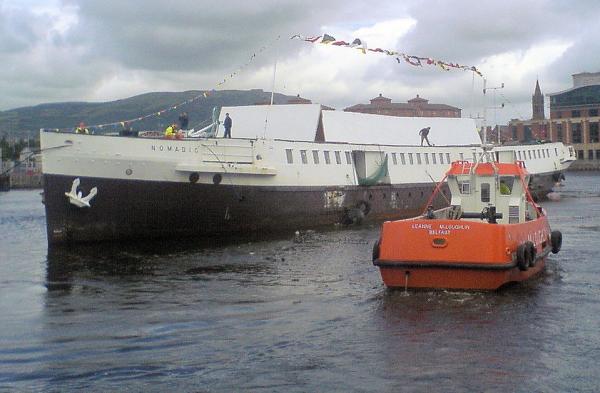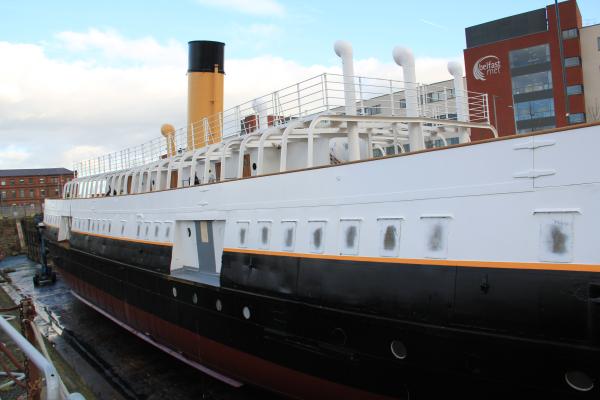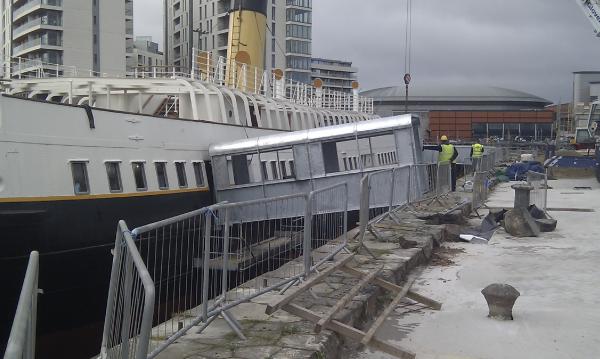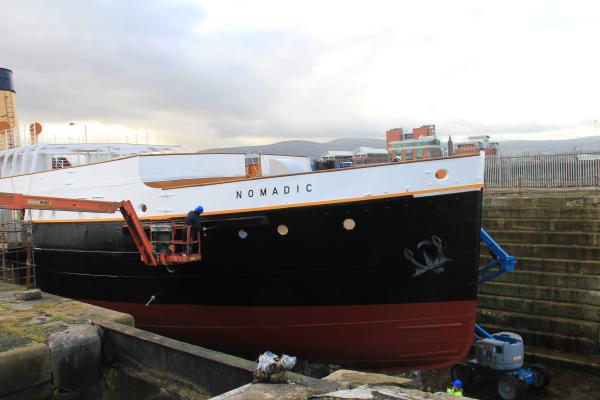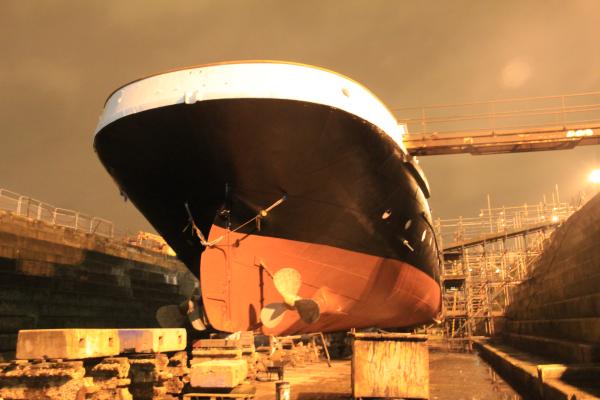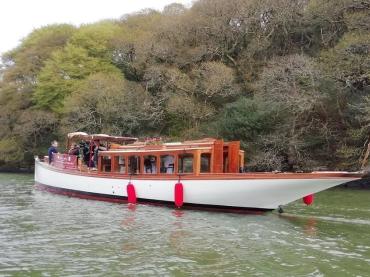

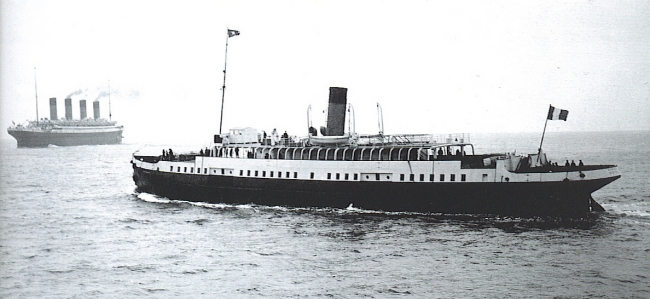
Previous names
- 1934 Ingenieur Minard
Details
Construction
Dimensions
History
SS NOMADIC was commissioned by the White Star Line as a tender to the ‘Olympic’ class transatlantic liners. The port at Cherbourg was too small to accommodate the Olympic class liners so two tender ships (SS NOMADIC and SS TRAFFIC) were stationed in the port, ready to rendezvous with the liners while they were at sea. The keel of SS NOMADIC (yard number 422) was laid by Harland and Wolff (H&W) in Belfast on 22 December 1910.
She was fitted with two H&W built compound steam engines which gave her a top speed of 12 knots. SS NOMADIC was launched from slip number one, Queens Island, Belfast on 25 April 1911 (OLYMPIC was built on slip number two and TITANIC on slip number three).
After the launch, she was fitted out in the Hamilton Graving Dock in the Abercorn Basin in Belfast and was delivered to White Star Line on 27 May 1911. Later in the same year, she sailed to Cherbourg to commence her duties. On 10 April 1912, NOMADIC delivered 142 passengers to TITANIC, including Sir Cosmo and Lady Duff Gordon and Benjamin Guggenheim. In the latter stages of World War One, NOMADIC was requisitioned and sent to Brest where she served as an American troopship. At the end of the war, she returned to Cherbourg where she continued to tend the transatlantic liners.
In 1927, White Star Line sold SS NOMADIC to the Compagnie Cherbourgeoise de Transborde-ment (CCT) and her intended career ended in 1934 when the new enlarged Port at Cherbourg was opened. She was then sold to The Societe Cherbourgeoise de Sauvetage et de Remorquage (SCSR) and renamed INGENIEUR MINARD. At the start of World War Two when France was under threat of invasion, NOMADIC evacuated British soldiers and others from Cherbourg and then made her way to Portsmouth where she was requisitioned by the British. She spent the remainder of the war in Government control as a coastal patrol vessel and minelayer and eventually returned to France for scrap. However, she was saved by the Manager of SCSR. In a twist of fate, the Port of Cherbourg had been destroyed and tender ships were once again essential. This time, she tended the likes of QUEEN MARY and QUEEN ELIZABETH.
This rejuvenated career ended on 4 November 1968. SS NOMADIC (whose original name had been reinstated) lay idle for five years. She was then sold to Mr Yvon Vincent who made extensive modifications to her including removal of the superstructure, funnel and engines and installed concrete ballast, a 100 seat auditorium and dance floor (which still remain). Many of the grand fixtures and fittings had gone missing by this stage. SS NOMADIC finally arrived in Paris on 17 October 1974 and moored opposite the Eiffel Tower. There she became a floating restaurant until she was forced to move to Le Havre by the French authorities. She was temporarily ‘listed’ by the French for one year and, following Mr Vincent’s death in March 2005, the French authorities requested NOMADIC be auctioned. However, the auction produced no bids.
At a later second auction held in Paris on 26 January 2006, she was bought by the Department of Social Development Northern Ireland (DSDNI) and transported back to Belfast on a barge. Restoration was due to be carried out and, pending this, NOMADIC was moored in the water at Queen Quay and then Barnets Dock in Belfast. In June 2006, Titanic Quarter Ltd and the Port of Belfast announced they would fund the refurbishment of the Hamilton Graving Dock to serve as a home for NOMADIC while she was being preserved and in 2009, she was moved there to complete a conservation management plan to move forward her restoration project.
Almost a hundred years after they originally built Nomadic, Harland & Wolff were appointed in 2011 to refurbish the ship, reinstating the bridge deck, flying bridge desk and the funnel. The interiors of the ship were returned to their original condition, with many of the original ornate panelling reinstated. The Hamilton Dock was also restored alongside the ship it now housed. The restored ship and dock opened to the public in 2013.
Maritime Belfast took on ownership of SS NOMADIC in 2015 as part of their remit to protect and promote the maritime and industrial heritage of Belfast. As of 2023, SS NOMADIC is now operated by Titanic Belfast Limited, Titanic Belfast’s commercial operator, who have aligned their 5 star visitor attraction experience to TITANIC’s little sister. The SS NOMADIC is the last remaining White Star Line ship anywhere in the world, an authentic piece of Belfast’s maritime heritage and the biggest Titanic artefact.
Significance
1. What is the vessel’s ability to demonstrate history in her physical fabric?
Evidence for designs, functions, techniques, processes, styles, customs and habits or uses and associations in relation to events and people. How early, intact or rare these features are may impact on significance.
SS NOMADIC’s hull is of traditional open-floor riveted steel construction and she has timber decks. She was fitted with two H&W built compound four cylinder steam engines with twin propellers which gave her a top speed of 12 knots. After her purchase in 1973 for use as a restaurant, extensive modifications were made including removal of the superstructure, funnel and engines. The flying bridge (part of the original design) and wheelhouse (added 1911-12) were some of the other items removed at this time, but these have subsequently been replicated, along with the funnel, engine casing and much of the accommodation. Concrete ballast was installed along with a 100 seat auditorium and a dance floor. Many of the fixtures and fittings have been lost but some items survive, such as the original windlass, bollards, a fairlead roller and the aft deck capstan on deck. Internally, some key features include: original panelling in the first and second class lounges; doors to the first and second class entrance vestibules; third class stairs; and the lamp room. The hold, chain locker and store also survive in their original form. In 2009 a comprehensive conservation management plan was implemented. This included the cleaning and painting of the hull, the reinstatement of bulkheads and the replacement or repair of corroded frames. Decking, fixtures and fittings have been replaced on the upper, stern, front well and flying bridge decks following original drawings, and all interior lounges, hallways and toilets have been reinstated and refitted. Both the exterior and interior of SS NOMADIC have been fully conserved to their original appearance. Only one original lifeboat survived and this was also salvaged and conserved.
2. What are the vessel’s associational links for which there is no physical evidence?
Associations with people or places. Off-ship research.
SS NOMADIC is unique in that she is the last surviving vessel of the White Star Line in the world. She was built by the famous shipbuilding company Harland and Wolff and is now one of only three surviving vessels from this yard, being launched from slip number one, Queens Island, Belfast on 25 April 1911 (OLYMPIC was built on slip number two and TITANIC on slip number three). On 10 April 1912 she brought passengers from Cherbourg to RMS TITANIC on her ill-fated maiden voyage and is a surviving reminder of the famous ship. Over the years, she also carried many renowned personalities to trans-Atlantic liners and is now one of three surviving vessels built to serve as a passenger tender, only two of which are UK vessels.
SS NOMADIC played a part in both World Wars, being requisitioned by the Admiralty in 1917 to assist in the First World War ferrying American troops from the troop carriers to the shore. During the Second World War, she evacuated British soldiers and others from Cherbourg, and then spent the remainder of the war as a British coastal patrol vessel and minelayer. She has strong connections with France, being built as a tender for the port of Cherbourg and returning there after the war, to support liners including the QUEEN MARY and QUEEN ELIZABETH. Later she was moved to Paris and moored opposite the Eiffel Tower. There she became a floating restaurant until she was forced to move to Le Havre by the French authorities and sold.
NOMADIC is well documented and has been recorded on the National Register of Historic Vessels since 2007 as a member of the National Historic Fleet.
3. How does the vessel’s shape or form combine and contribute to her function?
Overall aesthetic impact of the vessel, her lines, material she was built from and her setting. Does she remain in her working environment?
NOMADIC was designed for a specific role as a tender ferrying passengers to ocean liners moored off the French port of Cherbourg which was too shallow to accommodate them. She was built to carry 1000 passengers, 4 or 5 officers and 10 crewmen and had accommodation segregated into First, Second and Third Class accordingly. Much of the accommodation was removed in the 1970s during the conversion of the vessel for use as a restaurant, but the class structure has now been replicated as part of the conservation project, recapturing the grandeur of the first class experience and including key features such as the entrance staircases, foyers and lounges. The individual cabins such as the captain’s cabin, ship’s office, mate’s cabin and galley have also been replicated giving an accurate feel of what it would have been like to work or take a passage on board. NOMADIC has returned to the place where she was built and, as a static exhibit, serves to provide a practical illustration of the TITANIC story in Belfast.
Source: NHS-UK team, 19 November 2015.
With reference to the ss Nomadic conservation management plan.
This statement was developed as part of the Heritage Lottery funded First World War project. http://www.ww1britainssurvivingvessels.org.uk/
Key dates
-
1910-11
Built by Harland & Wolff for the White Star Line
-
1911
Sailed to Cherbourg to commence her duties
-
1912
Delivered 142 passengers to TITANIC, including Sir Cosmo and Lady Duff Gordon, and Benjamin Guggenheim
-
1916
Requisitioned and sent to Brest as an American troopship
-
1918
Returned to Cherbourg and continued to tend transatlantic liners
-
1927
Sold to the Compagnie Cherbourgeoise de Transborde-ment (CCT)
-
1927-34
Continued to operate as a tender
-
1934
Sold to The Societe Cherbourgeoise de Sauvetage et de Remorquage (SCSR) and renamed INGENIEUR MINARD
-
1940
Evacuated British soldiers and others from Cherbourg, making her way to Portsmouth where she was requisitioned
-
1940-45
Served as a coastal patrol vessel and minelayer Returned to France for scrap, but was saved by the Manager of SCSR
-
1945-68
Tended liners including QUEEN MARY and QUEEN ELIZABETH and was renamed SS NOMADIC
-
1968-73
Lay idle
-
1973
Sold to Mr Yvon Vincent who made extensive modifications including removal of the superstructure, funnel and engines and installation of concrete ballast, a 100 seat auditorium and dance floor
-
1974
Arrived in Paris and moored opposite the Eiffel Tower as a floating restaurant
-
2005
Auctioned by the French authorities following Mr Vincent’s death
-
2006
Bought by the Department of Social Development Northern Ireland (DSDNI) at a second auction and transported to Belfast for restoration
-
2006
Titanic Quarter Ltd and the Port of Belfast announced funding for the refurbishment of the Hamilton Graving Dock to serve as her home during restoration
-
2008
Nomadic Preservation Society formed
-
2008
A Sustainability Award of £2000 was made from the National Historic Ships Strategic Development Fund to cover the costs of a survey
-
2009
Moved to the Hamilton Dock
-
2013
Following a major restoration project, SS NOMADIC opens to the public as a visitor attraction
Grants
-
2020
£1.63m awarded to Titanic Belfast and SS Nomadic to support the recovery and re-opening of the attraction, as well as protect its future - a significant driver of global tourism for N.Ireland
-
2010/11
The Heritage Lottery Fund awarded £3,250,000 to the Nomadic & Hamilton Dock Development
-
August 2009
NOMADIC has recently been awarded a grant of £2 million and NCT are currently completing a conservation management plan. They hope to have this in place by September and will then move forward with the restoration project Source: Sean N
-
2007/2008
A Sustainability Award of £2000 was made to ss NOMADIC from the Strategic Development Fund of National Historic Ships to cover the costs of a survey
Sources
Arnault, Jean Charles, Nomadic, 2000
Moss, Michael & Hume, John, Shipbuilders to the World - 125 years of Harland and Wolff, Belfast 1861-1986, Blackstaff Press, 1986
Pritchard, Mervyn, The Belfast Child - SS Nomadic, Queen's Island Press, 2008
The Lone Star, Nomadic Preservation Society, Volume 1
Maritime Belfast Trust website, September 2023
Own this vessel?
If you are the owner of this vessel and would like to provide more details or updated information, please contact info@nationalhistoricships.org.uk

